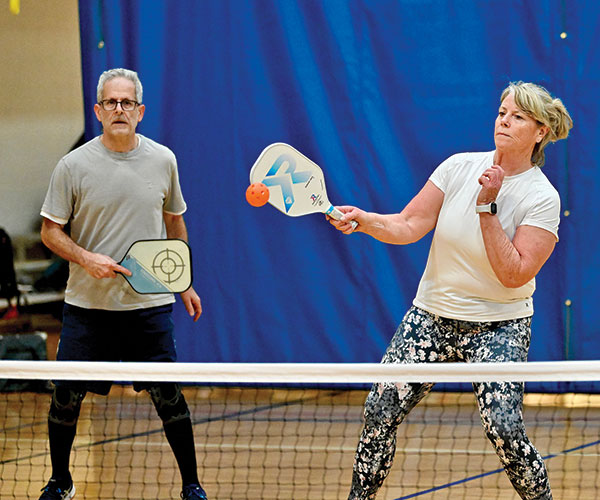Mary Neuman, 74, can often be found at sporting events cheering on her grandchildren from the stands. She takes frequent vacations to Florida. She has plenty to see and do.
But in 2002, Neuman, of North Royalton, started to notice her vision was becoming cloudy. "I just kept thinking I would wait a while and it was just time to change my glasses," she says. "I couldn't see things far away clearly. I could see, but it wasn't that great."
Eventually, Neuman returned to MetroHealth Hospital System, where she had worked as a nurse for more than 30 years, to see Dr. Michael Prokopius, director of the division of ophthalmology. He could tell immediately that she had cataracts. So in September 2003, Neuman underwent her first cataract eye surgery. "I was awake through the whole thing and Dr. Prokopius talked me through it all," Neuman says.
Her procedure and recovery took about two hours and she returned home the same day. "It was just overnight that I could really see things clearly at a distance," she says. She underwent surgery for her other eye six weeks later.
Many seniors, like Neuman, battle to see clearly. According to the National Eye Institute, 3.3 million Americans age 40 and older are affected by blindness. Eighty percent of eye problems for seniors fall into three common conditions: cataracts, glaucoma and macular degeneration, says Dr. Scott G. Smith, a member of the glaucoma division at the Cole Eye Institute of The Cleveland Clinic.
"After a patient reaches 50, they should get an eye exam every year," he says. Early detection and prevention are key in keeping eyes healthy and stopping these conditions from causing blindness.
"The biggest problem for senior citizens is going to be cataracts," says Prokopius, who performs about 300 cataract surgeries a year. "Everybody, to a certain extent, develops a cataract as they age."
You can take precautions for developing cataracts, such as good nutrition and wearing sunglasses to keep out harmful ultraviolet rays. The biggest risk factor is smoking because it reduces the amount of blood and oxygen to the eye.
But for most patients, nothing can be done to prevent them, says Smith.
Over time the lens of the eye becomes cloudy, making it difficult to see. "Patients typically come into the office with complaints of blurred vision or difficulty performing their activities of daily living," says Prokopius.
Some cataracts will not affect patients enough to consider surgery. But he says, "Many do come to the point where they need to have surgery for it."
During the surgery, the lens is removed from the eye and an artificial lens is replaced through a small incision in the eye.
Smith says cataract surgery has come a long way in the past 10 years. The former procedure required multiple sutures and a 9- to 10-millimeter incision that could cause inflammation of the eye. It took about six to eight weeks to fully recover from this surgery. The artificial lens placed into the eye was rigid, usually made out of Plexiglas.
The new procedure, he says, requires only a 3-millimeter cut because the artificial lens is a flexible plastic that can fit through a smaller incision. Recovery time takes about one to three weeks.
Most patients need glasses or contacts after the eye heals to help them see clearly. Prokopius says new lenses are being developed that will allow patients to see far away and up close, eliminating any new need for glasses.
Glaucoma is the most common cause of irreversible blindness. Smith says early detection is key, especially for those most at risk: people with a known family history of the disease and African Americans.
"This problem can gradually come on and people can lose their peripheral vision before they realize they have a problem," says Prokopius. "And if you keep losing your peripheral vision, you eventually go blind."
Glaucoma, once believed to be high pressure inside the eye, is actually a disease of the optic nerve, says Prokopius. "We lower their eye pressure in an attempt to control damage to their optic nerve," he says.
Gone are the days of using puffs of air in routine eye exams, says Prokopius. Now drops are placed in the eye and a probe is used to touch the surface and report eye pressure. Doctors can also look at the optic nerve and study it for damage.
There are four groups of medication used to manage glaucoma: prostaglandin analog, eye drops that increase the drainage of intraocular fluids; beta-blockers, drops that reduce the amount of fluid in the eye; alpha agonists, drops that help fluid leave the eye by decreasing production and increasing drainage; and carbonic anhydrase inhibitors, the only medication taken in pill form, used to decrease fluid production.
"Most people do require multiple medications," says Smith. "Surgery is not usually required. We can only hope to stabilize vision."
Macular degeneration is frequently a hereditary condition. The macula, part of the retina, can be gradually worn away. The damage is irreversible, but further damage can be slowed and stopped. "We try to stabilize it through treatment," says Smith.
Smokers are more susceptible to macular degeneration, says Prokopius. Smoking can increase the number of harmful chemicals absorbed into the bloodstream and stop protective nutrients from being delivered.
There are two kinds of macular degeneration: dry and wet. Dry macular degeneration is more common and not as severe. It causes vision to decrease slowly over time. While there is no cure for dry macular degeneration, Ocuvite PreserVision, a high-dose vitamin, can be used to slow the progression, says Prokopius.
Using an Amsler grid, similar to a checkerboard, can also monitor vision. "If the lines get wavy or disappear, we need to hear about that," he says. It can mean the macular degeneration is getting worse and could turn into the wet form.
Wet macular degeneration, the most severe eye condition, is associated with abnormal blood vessels that leak fluid. "With a click of their finger, their vision can be gone," says Prokopius. About 10 percent of macular degeneration cases are wet.
Most doctors treat wet macular degeneration with medications to close blood vessels. Sometimes photodynamic therapy, which injects a special drug into the bloodstream and uses a light to activate the drug, is used to shrink and close blood vessels. But Smith cautions that the blood vessels can reappear and patients will need multiple therapies for successful treatment.
The latest treatment, Macugen, which is the only one to be approved by the FDA for patients with all types of wet macular degeneration, blocks abnormal blood vessels from growing and leaking.
Prokopius says research is being done to determine the genes that cause glaucoma and macular degeneration. Doctors may be able to use gene therapy to cure them.
But for now, early detection remains the greatest tool for seniors to keep their eyes healthy. Seniors should have yearly eye exams and make sure testing is done to catch what could be the beginning of an eye disease.
For Neuman, being able to read and see her grandchildren grow up was very important. Treating her eye problem was something that was necessary and beneficial to her life, she says. "I recommend that any older person with eye problems do something. If they don't, then they are missing out on a lot."



